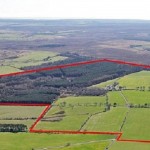“A Sirius Attempt”
- – an “In My View” article by NIGEL WARD
~
I have in my possession a scanned image.pdf document (comprising what purports to be copies of dozens of pages of letters and emails exchanged over a period of several months, beginning on 20th December 2011 and ending in March 2012) passed to me from within the depths of a multinational conglomerate, one of whose ‘fronts’ has made something of a name for itself in connection with the much-vaunted proposal to develop a potash extraction facility within the boundaries of the North Yorkshire Moors national Park – Sirius Minerals Plc.
I have necessarily abstracted the information I consider most relevant to providing the public with an insight into the correspondence; no doubt I will stand accused, perhaps by both Pro-Sirians and Eco-Defenders, of bias. Well, that’s tough; I call it as I see it.
The correspondence embodied in the documents purports to be between Marrons (a specialist law practice which focuses on planning and environmental work, acting in and on behalf of the Sirius subsidiary York Potash Ltd), and the Infrastructure Planning Commission (IPC) office in Bristol – as well as further correspondence involving Mr Richard HUNT, Head of Planning at York Potash Project (a Sirius subsidiary) in Scarborough, North Yorkshire, as well as a former colleague of Mr Graham CLARKE (the one-time Managing Director of Boulby Mine, who was recently head-hunted by York Potash Ltd).
Before considering the thrust of the correspondence, it is important to bear in mind that the IPC ceased to exist on 1 April 2012 and its work is now being taken over by a restructured Planning Inspectorate. (It is intended that there will be a seamless transition to a new National Infrastructure Directorate, created within the Planning Inspectorate, which will support the examination of major infrastructure applications). It may be serendipitous that the Sirius proposal has been timed to coincide with this period of flux.
It is a prerequisite of the application process that applicants must begin by requesting a formal Screening Opinion under Regulation 6(l){a} of the Infrastructure Planning (Environmental Impact Assessment) Regulations 2009, and it is this request which forms the starting point of the purported correspondence.
My informant is at pains to point out that the correspondence constitutes an attempt on the part of Sirius to lead the IPC into accepting, amongst other things, the proposition that the pipeline element of their proposals falls outside of existing legislative requirements.
“Both the extraction of the mineral ore (the minehead) and the processing of the ore (the processing plant) are dealt with under separate legislation and planning/EIA processes. They will undergo screening within those processes at the appropriate time but neither of them constitutes a “nationally significant infrastructure project” within the terms of the Planning Act 2008. This Screening Request therefore relates only to the proposed pipeline.”
The Marrons submission then proceeds to argue that neither the regulations per se, nor the relevant case law, are applicable to the Sirius proposal – which has been carefully engineered to preclude that possibility – eg: proposing four pipes (for transporting ‘slurry’ – a mixture of potash and water) of 750mm diameter, and up to 60km in length, whereas pipes 800mm diameter and over 40km in length are strictly regulated.
Similarly, the Marrons submission seeks to avoid the customary classification of pipelines under the regulations relating to ‘aqueducts’, on the grounds that the OED defines ‘aqueduct’ as “an artificial channel for the conveyance of water from place to place” – whereas the Sirius pipes are intended to carry water with potash in suspended solution – as if water were no longer water if it carries within it 0.2mm diameter particles of potash.
Marrons then argue that the regulations in respect of pipelines refer to “oil, gas and chemicals”, whereas it is their contention that 0.2mm diameter potash particles suspended in water does not constitute a “chemical” at all.
With respect to the area of land required for the Sirius installation, a similar ‘hair-splitting’ approach appears to have been taken, by specifying not one but four discreet areas of operation – one of 4 hectares (a hectare is a metric unit of area defined as 10,000 square metres – ie 100 m by 100 m), and the other three of 1.5 hectares each. For ease of visualization, a 4 hectare plot equates to approximately eight American football fields. Similarly, 1.5 hectares equals approximately 3 American football fields.
Whilst the Marrons document does not specify exact locations, it does confirm that:
“lt is acknowledged that the pipelines will cross 1,700 metres of Special Protection Areas at Liverton Moor/Waupley Moor. In physical terms, this will mean the disturbance of a corridor that is 45 metres wide.”
On 29th December 2011, Laura ALLEN of the IPC responded to the Screening request, noting that the regulations require a plan sufficient to identify the land. The letter goes on to request a great deal more information, including:
1) Information on the characteristics of the development
- Clarification about any potential sterilisation affecting the future use of the land following the installation of the pipelines;
- A clearer indication of the likely construction periods for each of the proposed route corridors, including the stages of the construction programme and the duration of each stage;
- Brief details of the proposed construction methods used for laying the pipelines and an indication of potential sources of pollution and nuisances, for example brief details of the method proposed to be used when crossing water bodies, roads and railways;
- An indication of the quantity and type of construction waste, including material to be excavated, a brief description of its method of removal from the site and how it will be re-used onsite (if applicable);
- An indication of the location of laydown and access tracks and a brief description of the works required, for example, to provide temporary access across water bodies,
- A brief description of noise and vibration sources and impacts; and
- A brief description of the cumulative effects of potential impacts of the project during construction and operation (such as noise or impacts on landscape and ecological assets) taken with other relevant plans or projects, including both the extraction and processing of the ore and any development at the ports of Teesside and Immingham.
2) Information on the location of the development
- Reference is made to the inclusion of statutory designations within the corridor routes including the named Liverton Moor/Waupley Moor SPA and the North York Moors National Park, as well as unidentified Sites of Special Scientific Interest (SSSI) and a Heritage Coast. The names of the SSSI and the Heritage Coast should be provided. The location of all of these sites should be clearly identified on a plan in the context of both proposed route corridors. In addition, information should be provided on the size of the physical area of these statutory designations which would be affected by the proposed project and the nature of the potential impact. Clarification should also be provided on whether any regional, county or local wildlife or landscape designated sites are also included within the route corridors;
- Identification of the location of sensitive visual receptors which may be affected during construction, for example the National Park;
- Reference is made on page 8 of the letter to possible impacts on heritage and ecological assets due to disturbance during construction. Please name the assets (including clarification about the potential impacts on European Protected Species) and provide a brief description of the location and nature of the asset, for example, grade II* listed building and provide an indication of how it may be affected by the proposed development and the significance of the impact. It may be helpful to provide this information in a short table format;
- An indication of the existing land use(s) within both proposed route corridors; and
- Identification of key water bodies which may be affected by the proposed project, including information on whether these are designated as a Main River.
3) Other information
-
An indication of the approach taken to categorising potential impacts for example “short-term visual” and “adverse but temporary” which leads you to the conclusion that there will be no likely significant effects taking into account matters such as probability, duration and reversibility (see Schedule 3 of the EIA Regulations).
Bearing in mind that Marrons claim to have “repeatedly been identified as the leading planning law firm in the Midlands for the last 14 years”, they certainly seem to have taken a somewhat minimalist approach to providing the IPC with the necessary facts.
On 31st January 2012, Mr Richard HUNT (Head of Planning at York Potash), emailed Kath HADRELL at the IPC (copying in Laura Allen), complaining that:
“We had hoped that a definitive decision would be possible from the information that we had provided. Bearing this in mind we then looked at the additional information that has been requested and some of it is in such detail that it would appear that we would have to pin down the final route of the pipeline and we felt that this was predetermining the route and we cannot supply that information without prejudicing the ability to relocate within a wider application corridor to allow for minor adjustments”.
On 6th February, Laura ALLEN (IPC) responded to Richard HUNT (York Potash) on Kath HADRELL’s behalf, again requesting more detailed information, and exhibiting some degree of impatience:
“You have also indicated in your email, that there are issues around providing the information that the IPC requested in its letter to Marrons of 29 December 2011. We suggest that you set out any such issues in full in a formal response to that letter, which we would be grateful to receive. We look forward to hearing from you.”
On 10th February, Richard HUNT (York Potash) wrote back to Laura Allen (IPC), this time under a York Potash letter-head. In my view, his tone is waxing somewhat tetchy, especially here:
- The proposed development for which the request has been made does not extract any mineral – it does not, therefore, fall within the definition of a ‘surface industrial installation for the … extraction of … ores’. The mineral operation is not infrastructure and is not of a type of development that is mentioned in Section 14 of the Planning Act 20DS. It would take place underground and the crushed and ground mineral ore would be transported via a conveyor to the pipeline and its associated development. We consider that the NSIP is adequately described in the original Screening request and the ore mixing equipment and pumping equipment mentioned in that document is the ‘associated development’. This view is strongly supported by Regulation 3 (‘Meaning of “pipeline”’) of the Pipeline Safety Regulations 1996 [Ref SI 1996:825] and the accompanying Guide to the Regulations published by the Health and Safety Executive [ISBN 97SU717611S29] and neither the minehead nor the processing plant are included in this definition.
On 2nd March 2012, Sheila TWIDELL of Environmental Impact Assessment (EIA – on behalf of the IPC, which was in the process of ceasing operations) wrote to Marrons offering an official Screening Opinion, which concludes that:
“However, the IPC considers, in the absence of any technical evidence or legal interpretation to the contrary, that it would be unreasonable to conclude that the proposed development falls within any of the relevant development descriptions in Schedule 1 or Schedule 2 although it is ultimately for the courts to interpret the law. The IPC has therefore decided that the proposed development is not EIA development for the purposes of the EIA Regulations.”
That line is worthy of repetition:
“The IPC has therefore decided that the proposed development is not EIA development for the purposes of the EIA Regulations.”
EIA, remember, stands for Environmental Impact Assessment.
Then follows an extensive list of requirements that York Potash Ltd (i.e. Sirius) has yet to fulfill, including:
- Flood Risk Assessment
- Habitats Regulations Assessment report
- Ecological impact assessment report
- Ecological impact assessment plan
- Archaeological and historic environment impact assessment report
- Archaeological and historic environment impact assessment plan
- Visual impacts report and landscape plan
- Visual impacts report and landscape strategy
- Water management plan
- Noise and vibration assessment report
- Transport assessment
- Land quality report
- Land use report
- Construction environmental management plan
In summation, it is abundantly clear that Sirius has a larger number of hurdles to clear (as far as planning approval is concerned) than has yet been admitted to press and public.
But it is the opinion expressed in the Boulby emails that will perhaps give the greatest cause for concern to the Pro-Sirians. The York Potash test-bores have apparently located very significant deposits. However, extraction is now recognized to be fraught with enormous technical challenges, because the seams are over 350 feet deeper than any other potash mine in the world. This poses the dual problems of unprecedentedly high working temperatures and increased surface-to-face transit times.
Within the context of the rigorous controls outlined above, the questions that remain, for Pro-Sirians and Eco-Defenders alike, are these:
1) Can the extraction of the potash be accomplished in a way that is economically viable?
2) Can that be achieved without harming the integrity of the National Park?








![“Economical With The Truth?” [Part Two]](http://nyenquirer.uk/wp-content/uploads/2014/06/ed_asquith-150x150.jpg)
![“Economical With The Truth?” [Part One]](http://nyenquirer.uk/wp-content/uploads/2014/06/ROGUE_Council1-150x150.jpg)















Comments are closed.